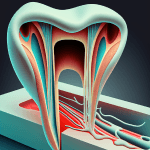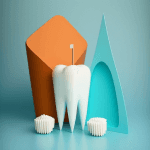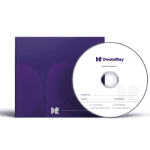Bitewing X-Ray
Bitewing X-Ray
Bitewing X-Ray
Named after the small tab on the intraoral phosphor plates that the patient bites on, resembling aircraft wings, Bitewings is a common and popular dental X-ray.
Named after the small tab on the intraoral phosphor plates that the patient bites on, resembling aircraft wings, Bitewings is a common and popular dental X-ray.
Named after the small tab on the intraoral phosphor plates that the patient bites on, resembling aircraft wings, Bitewings is a common and popular dental X-ray.

Understanding Bitewings
Bitewings is an intraoral examination, illustrating the crown of the upper and lower teeth of the same patient side on a fluorographic phosphor film. Its high diagnostic value makes it a fundamental and necessary imaging tool for dentists to highlight potential caries undetectable in a clinical examination.
A Bitewings series typically consists of four X-rays - two for each side. In young children, sometimes only one Bitewing X-ray per side is necessary.
The frequency of Bitewing X-rays depends on various factors, including age, tooth development stage, and caries development risk. During childhood or adolescence, or for adults with high caries rate, Bitewing X-rays can be taken every 6 to 12 months. Frequent requests are intended to prevent late detection and rapid cary spread, potentially requiring extensive treatment or even resulting in tooth loss.
Understanding Bitewings
Bitewings is an intraoral examination, illustrating the crown of the upper and lower teeth of the same patient side on a fluorographic phosphor film. Its high diagnostic value makes it a fundamental and necessary imaging tool for dentists to highlight potential caries undetectable in a clinical examination.
A Bitewings series typically consists of four X-rays - two for each side. In young children, sometimes only one Bitewing X-ray per side is necessary.
The frequency of Bitewing X-rays depends on various factors, including age, tooth development stage, and caries development risk. During childhood or adolescence, or for adults with high caries rate, Bitewing X-rays can be taken every 6 to 12 months. Frequent requests are intended to prevent late detection and rapid cary spread, potentially requiring extensive treatment or even resulting in tooth loss.
Understanding Bitewings
Bitewings is an intraoral examination, illustrating the crown of the upper and lower teeth of the same patient side on a fluorographic phosphor film. Its high diagnostic value makes it a fundamental and necessary imaging tool for dentists to highlight potential caries undetectable in a clinical examination.
A Bitewings series typically consists of four X-rays - two for each side. In young children, sometimes only one Bitewing X-ray per side is necessary.
The frequency of Bitewing X-rays depends on various factors, including age, tooth development stage, and caries development risk. During childhood or adolescence, or for adults with high caries rate, Bitewing X-rays can be taken every 6 to 12 months. Frequent requests are intended to prevent late detection and rapid cary spread, potentially requiring extensive treatment or even resulting in tooth loss.
Understanding Bitewings
Bitewings is an intraoral examination, illustrating the crown of the upper and lower teeth of the same patient side on a fluorographic phosphor film. Its high diagnostic value makes it a fundamental and necessary imaging tool for dentists to highlight potential caries undetectable in a clinical examination.
A Bitewings series typically consists of four X-rays - two for each side. In young children, sometimes only one Bitewing X-ray per side is necessary.
The frequency of Bitewing X-rays depends on various factors, including age, tooth development stage, and caries development risk. During childhood or adolescence, or for adults with high caries rate, Bitewing X-rays can be taken every 6 to 12 months. Frequent requests are intended to prevent late detection and rapid cary spread, potentially requiring extensive treatment or even resulting in tooth loss.

Indications
Bitewing X-rays are indicated in conjunction with a clinical examination to highlight:
Caries and dental substance loss
Crown fractures
Periodontal bone loss
Pulp anatomy
Prosthetic work placement
Indications
Bitewing X-rays are indicated in conjunction with a clinical examination to highlight:
Caries and dental substance loss
Crown fractures
Periodontal bone loss
Pulp anatomy
Prosthetic work placement
Indications
Bitewing X-rays are indicated in conjunction with a clinical examination to highlight:
Caries and dental substance loss
Crown fractures
Periodontal bone loss
Pulp anatomy
Prosthetic work placement
Indications
Bitewing X-rays are indicated in conjunction with a clinical examination to highlight:
Caries and dental substance loss
Crown fractures
Periodontal bone loss
Pulp anatomy
Prosthetic work placement

Procedure: How is a Bitewing Test Performed?
Executing a Bitewing X-ray requires no special preparation. The patient is seated while the operator uses special X-ray retainers and the parallel cone technique, to scan the crown of the upper and lower teeth of each side on a special phosphor film placed inside the mouth.
Following this, the image is transferred to a computer using a special scanner. The parallelization method used to visualize teeth helps reduce magnification and avoid overlapping images.
Procedure: How is a Bitewing Test Performed?
Executing a Bitewing X-ray requires no special preparation. The patient is seated while the operator uses special X-ray retainers and the parallel cone technique, to scan the crown of the upper and lower teeth of each side on a special phosphor film placed inside the mouth.
Following this, the image is transferred to a computer using a special scanner. The parallelization method used to visualize teeth helps reduce magnification and avoid overlapping images.
Procedure: How is a Bitewing Test Performed?
Executing a Bitewing X-ray requires no special preparation. The patient is seated while the operator uses special X-ray retainers and the parallel cone technique, to scan the crown of the upper and lower teeth of each side on a special phosphor film placed inside the mouth.
Following this, the image is transferred to a computer using a special scanner. The parallelization method used to visualize teeth helps reduce magnification and avoid overlapping images.
Procedure: How is a Bitewing Test Performed?
Executing a Bitewing X-ray requires no special preparation. The patient is seated while the operator uses special X-ray retainers and the parallel cone technique, to scan the crown of the upper and lower teeth of each side on a special phosphor film placed inside the mouth.
Following this, the image is transferred to a computer using a special scanner. The parallelization method used to visualize teeth helps reduce magnification and avoid overlapping images.

Results and Radiation Exposure
The X-ray examination results are printed immediately and can also be sent electronically to the patient and their dentist upon request.
The radiation from a Bitewing X-ray is minuscule and can be safely performed on pregnant women if necessary. Our modern equipment ensures minimal radiation exposure for the best results, using a digital scanner system with high-sensitivity phosphor plates and the parallel cone technique reduces scattered radiation.
Results and Radiation Exposure
The X-ray examination results are printed immediately and can also be sent electronically to the patient and their dentist upon request.
The radiation from a Bitewing X-ray is minuscule and can be safely performed on pregnant women if necessary. Our modern equipment ensures minimal radiation exposure for the best results, using a digital scanner system with high-sensitivity phosphor plates and the parallel cone technique reduces scattered radiation.
Results and Radiation Exposure
The X-ray examination results are printed immediately and can also be sent electronically to the patient and their dentist upon request.
The radiation from a Bitewing X-ray is minuscule and can be safely performed on pregnant women if necessary. Our modern equipment ensures minimal radiation exposure for the best results, using a digital scanner system with high-sensitivity phosphor plates and the parallel cone technique reduces scattered radiation.
Results and Radiation Exposure
The X-ray examination results are printed immediately and can also be sent electronically to the patient and their dentist upon request.
The radiation from a Bitewing X-ray is minuscule and can be safely performed on pregnant women if necessary. Our modern equipment ensures minimal radiation exposure for the best results, using a digital scanner system with high-sensitivity phosphor plates and the parallel cone technique reduces scattered radiation.

Advantages and Unique Features:
Using the parallel cone technique, a Bitewing X-ray offers:
High definition
High resolution
Reduced magnification
Absence of coprojections of anatomical structures
Bitewing is the preferred X-ray type for caries detection and is also widely used to investigate pathologies not discernible from other imaging methods (e.g., panoramic X-ray).
Advantages and Unique Features:
Using the parallel cone technique, a Bitewing X-ray offers:
High definition
High resolution
Reduced magnification
Absence of coprojections of anatomical structures
Bitewing is the preferred X-ray type for caries detection and is also widely used to investigate pathologies not discernible from other imaging methods (e.g., panoramic X-ray).
Advantages and Unique Features:
Using the parallel cone technique, a Bitewing X-ray offers:
High definition
High resolution
Reduced magnification
Absence of coprojections of anatomical structures
Bitewing is the preferred X-ray type for caries detection and is also widely used to investigate pathologies not discernible from other imaging methods (e.g., panoramic X-ray).
Advantages and Unique Features:
Using the parallel cone technique, a Bitewing X-ray offers:
High definition
High resolution
Reduced magnification
Absence of coprojections of anatomical structures
Bitewing is the preferred X-ray type for caries detection and is also widely used to investigate pathologies not discernible from other imaging methods (e.g., panoramic X-ray).

Why Choose Dentalray?
At Dentalray, we have extensive experience, knowledge, and a specialized staff for the effective execution of complex and demanding diagnostic exams.
Bitewing X-rays require placing the X-ray film inside the patient's mouth, demanding the operator's experience. Dentalray's examination of Bitewings is performed with dental X-ray retainers that ensure no magnification and avoid the coprojection of other anatomical structures. Our perpendicular beam on the tooth's longitudinal axis offers correct visualization of interdental spaces.
With state-of-the-art digital dental equipment and high-resolution dental scanners, we ensure X-rays of high diagnostic value, free from artifacts, magnifications, and false images. Our years of experience and case management equip us to handle even the most demanding scenarios promptly. Trust Dentalray for thorough, precise, and effective dental diagnostics.
Why Choose Dentalray?
At Dentalray, we have extensive experience, knowledge, and a specialized staff for the effective execution of complex and demanding diagnostic exams.
Bitewing X-rays require placing the X-ray film inside the patient's mouth, demanding the operator's experience. Dentalray's examination of Bitewings is performed with dental X-ray retainers that ensure no magnification and avoid the coprojection of other anatomical structures. Our perpendicular beam on the tooth's longitudinal axis offers correct visualization of interdental spaces.
With state-of-the-art digital dental equipment and high-resolution dental scanners, we ensure X-rays of high diagnostic value, free from artifacts, magnifications, and false images. Our years of experience and case management equip us to handle even the most demanding scenarios promptly. Trust Dentalray for thorough, precise, and effective dental diagnostics.
Why Choose Dentalray?
At Dentalray, we have extensive experience, knowledge, and a specialized staff for the effective execution of complex and demanding diagnostic exams.
Bitewing X-rays require placing the X-ray film inside the patient's mouth, demanding the operator's experience. Dentalray's examination of Bitewings is performed with dental X-ray retainers that ensure no magnification and avoid the coprojection of other anatomical structures. Our perpendicular beam on the tooth's longitudinal axis offers correct visualization of interdental spaces.
With state-of-the-art digital dental equipment and high-resolution dental scanners, we ensure X-rays of high diagnostic value, free from artifacts, magnifications, and false images. Our years of experience and case management equip us to handle even the most demanding scenarios promptly. Trust Dentalray for thorough, precise, and effective dental diagnostics.
Why Choose Dentalray?
At Dentalray, we have extensive experience, knowledge, and a specialized staff for the effective execution of complex and demanding diagnostic exams.
Bitewing X-rays require placing the X-ray film inside the patient's mouth, demanding the operator's experience. Dentalray's examination of Bitewings is performed with dental X-ray retainers that ensure no magnification and avoid the coprojection of other anatomical structures. Our perpendicular beam on the tooth's longitudinal axis offers correct visualization of interdental spaces.
With state-of-the-art digital dental equipment and high-resolution dental scanners, we ensure X-rays of high diagnostic value, free from artifacts, magnifications, and false images. Our years of experience and case management equip us to handle even the most demanding scenarios promptly. Trust Dentalray for thorough, precise, and effective dental diagnostics.








